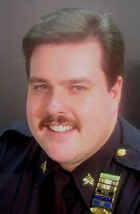
We've gotten together bestselling author
Iris Johansen and real-life forensic artist and veteran
northern New Jersey police sergeant Daniel Sollitti for
a Q&A session. What comes up when fiction meets fact?
Read on to find out.
Mr. Sollitti completed his formal forensic
art training at the United States Secret Service Training
Facility in Maryland and studied 3-Dimensional clay reconstruction
of a skull under forensic sculptor Seth Wolfson. Ms.
Johansen's newest hardcover, COUNTDOWN, is her sixth
thriller featuring forensic sculptor Eve Duncan.
 |
| Photo © Bernard Vidal |
| |
 |
| Photo © Stephen T. Golecki |
IJ to DS: I have a routine
as a writer, setting aside time every morning to work
on my novels. I've given Eve Duncan a routine for her
forensics, retreating into her private studio to work
for hours on end, and into the night, when there is a
project on hand. You must have a schedule for your forensic
work. Is it anything like what I've created for Eve?
Does it vary if you're creating a sculpture or drawing?
Answer: As a police
officer, forensic art is done in addition to my regular
duties. Full time, I'm assigned as a supervisor in
the Bureau of Criminal Identification. I oversee a
team of police officers who take, classify, and file
the fingerprints of all persons arrested. They also
do crimescene photography and latent fingerprint work.
Since I work in a densely populated city in the Northeast,
the finding of skeletal remains is an unusual occurrence.
My reconstructions usually come from areas that have
desert regions or densely wooded areas and even from
the mountains. When a forensic case does come in, however,
I throw myself at it, and the hours seem to fly by.
I have to be reminded to eat or sleep. Unfortunately,
patience is a quality I must remind myself to practice.
That is why I enjoy the process of sketching the reconstruction.
Once the tedious work of cutting and placing depth
markers on a mounted skull is complete, and 1:1 photographs
are taken, I love to let my pencil flow and just "find" the
victim's features. I can complete a sketch in several
hours. By this time, my natural curiosity takes over
and I want to see the victim's face as soon as possible.
The sculpture method is much more time intensive. Texture
in the face that takes hours in the bust is accomplished
in a few seconds with some strokes of a pencil.
DS to IJ: When I work
on a reconstruction, I'm working with existing physical
facts and materials. As a writer, you create solely from
imagination. One of the motivations in my work is Project
EDAN (Everyone Deserves a Name). When you first created
Eve Duncan, she had the same desire--to give anonymous
victims a name--and it motivates her still in the new
books like BLIND ALLEY and COUNTDOWN. My interest in
Project EDAN is derived from my law enforcement background.
How did you come up with Eve's?
Answer: Eve's desire
to identify and bring "the lost ones" home was based
on her background and character. Her love for her murdered
daughter, Bonnie, and the knowledge that she had never
found her was a constant torment and spurred Eve to
help other parents in similar situations.
Thankfully, I have no such personal
history. I first happened on forensic sculpting while
watching a TV documentary. It fascinated me and immediately
brought a swirling barrage of questions and possibilities:
What would lead a person to such a career? What if
the motivation was both tragic and personal? In this
case, the career preceded the creation of the character.
DS to IJ: Let's talk
about characters and affiliations. Project EDAN supplies
forensic art and reconstruction to "cold case" unidentified
missing persons and law enforcement agencies that do
not have access to forensic artists. So, like Eve and
Jane--the artist is not formally affiliated with a law
enforcement agency. Why did you choose to have your heroes
be independent artists, as it were? Do you think that
makes them more vulnerable to the cases that envelop
them?
Answer: Yes, I did
want my artists to be vulnerable and independent. The
first reason is simply that keeping Eve independent
means that her work can come from anywhere. For example,
at the opening THE FACE OF DECEPTION--the first Eve
Duncan suspense novel--she is working on a skull sent
to her by the Chicago PD. She lives in the Atlanta
area and is known to the police there, so more often
than not her work is local. But it doesn't have to
be. Secondly, I felt that independence would make them
more vulnerable. Eve and Jane have never been trained
by law enforcement either in tactics and weaponry or
in distancing themselves emotionally from the job.
Nor are they bound by the protocols of an officer,
partnership, precinct, etc. And finally, frankly, lifting
the restrictions of protocol gives me more freedom
as a writer. I can fully immerse one or both of them
in the suspense itself. I can craft my novels so they
brim (I hope) with the adventure and fast-paced, tightly
woven plotting that can come from giving your lead
characters a personal stake in the outcome of the story.
IJ to DS: My hero Eve
Duncan is a forensic sculptor. Jane MacGuire is a sketch
artist. You are both. Please tell us a little bit about
the similarities and differences of working in these
media.
Answer: I'm a natural
pencil artist in so far as it's a medium I feel most
comfortable with. I've drawn since I was a child. Pencil,
crayons, chalk ... whatever. I've always loved to draw.
My rendering of human faces brought me into forensic
art, specifically composite drawing. Two-dimensional
reconstruction (sketching) of human remains was just
a natural extension. I never had much experience with
clay sculpting until I found its forensic application.
The sculpture captures the 3-dimensional quality of
a person. This is especially useful if the person has
a unique profile. I believe in doing both a sculpture
and a sketch. Some viewers react better to one form
than the other. In the end, whatever type of reconstruction
triggers a recognition is the way to go.
DS to IJ: You've made
Jane a painter, and she, like Eve, has assisted the Atlanta
Police Department. We know from your early books that
Jane was a computer whiz. Yet, despite forensic sciences
relying on computer generation, you've chosen to have
her hand-draw her composites. From my work I know that
the success rate of hand-drawn composites is higher than
computer generated ones since you can incorporate more
perspectives and minute details. Is that why you chose
to steer Jane the way you did?
Answer: During my research
I learned that the accuracy factor was higher in hand-drawn
composites. But I also wanted to include the psychological
insight between artist and witness. Exploring this
connection is yet another way for me to immerse Jane
in the novel's action. Focusing on hand-rendered images
also allows me to explore concepts that have always
personally fascinated me: the artistic force of instinct
and the power of the creative drive.
DS to IJ: For me, the
trickiest parts of recreating a face are the nose, hair,
and eye color, as they are subjective rather than scientific.
What does Eve Duncan struggle with?
Answer: Eve has problems
with the same areas that you do. I expect that most
forensic artists would agree that these are the hardest
areas. In a profession of exact measurements, as forensic
sculpture is, the subjective is always the hardest.
As I've become more familiar with forensics, my admiration
of the forensic sculptor has grown enormously. That's
why I always try to stress the initial painstaking
work and then I let Eve's instincts take over. What
sets Eve apart from her peers in the novels is her
ability to sense the spirit of a "lost one" in addition
to his/her physiology.
IJ to DS: Let's turn
our attention to everyday practicalities. Eve Duncan
works in consultation to the Atlanta PD. Although she
has a modern studio and equipment, she doesn't have anything
like what television viewers are seeing on CSI and
other forensic television shows in terms of manpower,
resources, and technology. How real are those shows in
terms of what a "normal" police department
would maintain?
Answer: Believe it
or not, I don't watch many cop or CSI type shows. I
get enough of the real stuff at work. Sometimes these
shows hurt law enforcement because they create unrealistic
expectations. The television-educated public, when
chosen as jurors, expect some high tech, magical forensic
whiz to waltz onto the stand and "crack" the
case for them. I think they are disappointed when an
investigator stands before them with a blow-up of a
latent and points out minute details in a print and individualizes
it to a suspect. I can attest to this: any real police-maintained
facility would probably be cluttered. There would be
a caffeinated beverage within reach. And finally, there
would be a highly dedicated individual tucked away,
doing some very important work to give justice to a
person he never met.
IJ to DS: Thank you for
taking the time to give my readers even more insight
into the work of a forensic artist. Best of luck in your
work.
DS to IJ: I'm delighted
to have had this opportunity to share ideas with you.
Thank you for inviting me to participate.
